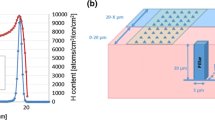Abstract
Steels used to construct nuclear reactor pressure vessels are low-alloy ferritic steels. These steels should have good impact properties, i.e., low transition temperature and high upper shelf energy, both before and during service conditions. The most important service condition is the neutron irradiation. Extensive research and development was conducted to develop such steels. Instrumented impact testing was conducted on three advanced pressure vessel steels and, for comparison, a conventional pressure vessel steel. Both microstructures and fracture surfaces were examined using optical and scanning electron microscopic (SEM) techniques. In general, the advanced steels showed much better impact properties (lower ductile-brittle transition temperature and higher upper shelf energy) than the conventional steel. Loadtime traces showed that increase in the fracture energy was mainly due to increase in the fracture propagation energy rather than the initiation energy. Improvement in the toughness level of the advanced steels compared to that of the HSST steel was related to the difference in chemical composition, microstructure, and fracture surface morphology.
Similar content being viewed by others
References
“Analysis of the Behaviour of Advanced Reactor Pressure Vessel Steels under Neutron Irradiation,” IAEA Tech. Rep. 256, Interna-tional Atomic Energy Agency, 1986
J.R. Hawthorne, inTreatise on Materials Science and Technology, Vol 25. CL. Briant and S.K. Banerji, Ed., Academic Press, 1983, p 461–524
S. Kawaguchi, et al.,Nucl. Eng. Des., Vol 81, 1984, p 219–229
K. Kussmaul,Nucl. Eng. Int., Dec. 1984,p41–46
ASTME23-72,AnnualBook of ASTM Standards, Part 10ASTM, 1980
W.L. Server,J. Eng. Mater. Technol., Vol 100, 1978, p 183
T. Gladman and F. Pickering, inYield, Flow and Fracture of Polycrystals, T.N. Baker, Ed., Applied Science Publishers, 1983,p 161
R.W. Hertzberg,Deformation and Fracture Mechanics of Engineering Materials, John Wiley & Sons, 1989, p 365
A.S. Tetelman and A.J. McEvily,Fracture of Structural Materials, John Wiley & Sons, 1967, p 268,523
I.C. Howard and A.A. Willoughby, inDevelopments in Fracture Mechanics-2, G.G. Chell, Ed., Applied Science Publishers, 1983, p 39-99
R.O. Ritchie and A.W. Thompson,Metall. Trans. A, Vol 16,1985, p 233–248
Author information
Authors and Affiliations
Rights and permissions
About this article
Cite this article
Ghoneim, M., Nasreldin, A.M., Elsayed, A.A. et al. Instrumented impact properties of some advanced nuclear reactor pressure vessel steels. JMEP 5, 328–334 (1996). https://doi.org/10.1007/BF02649335
Issue Date:
DOI: https://doi.org/10.1007/BF02649335



